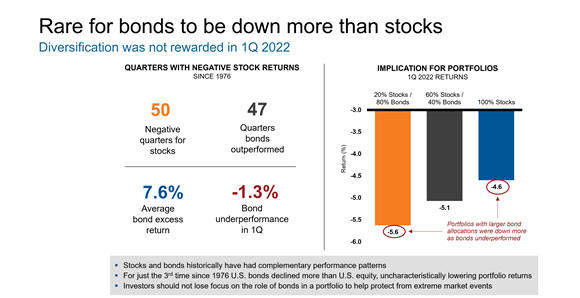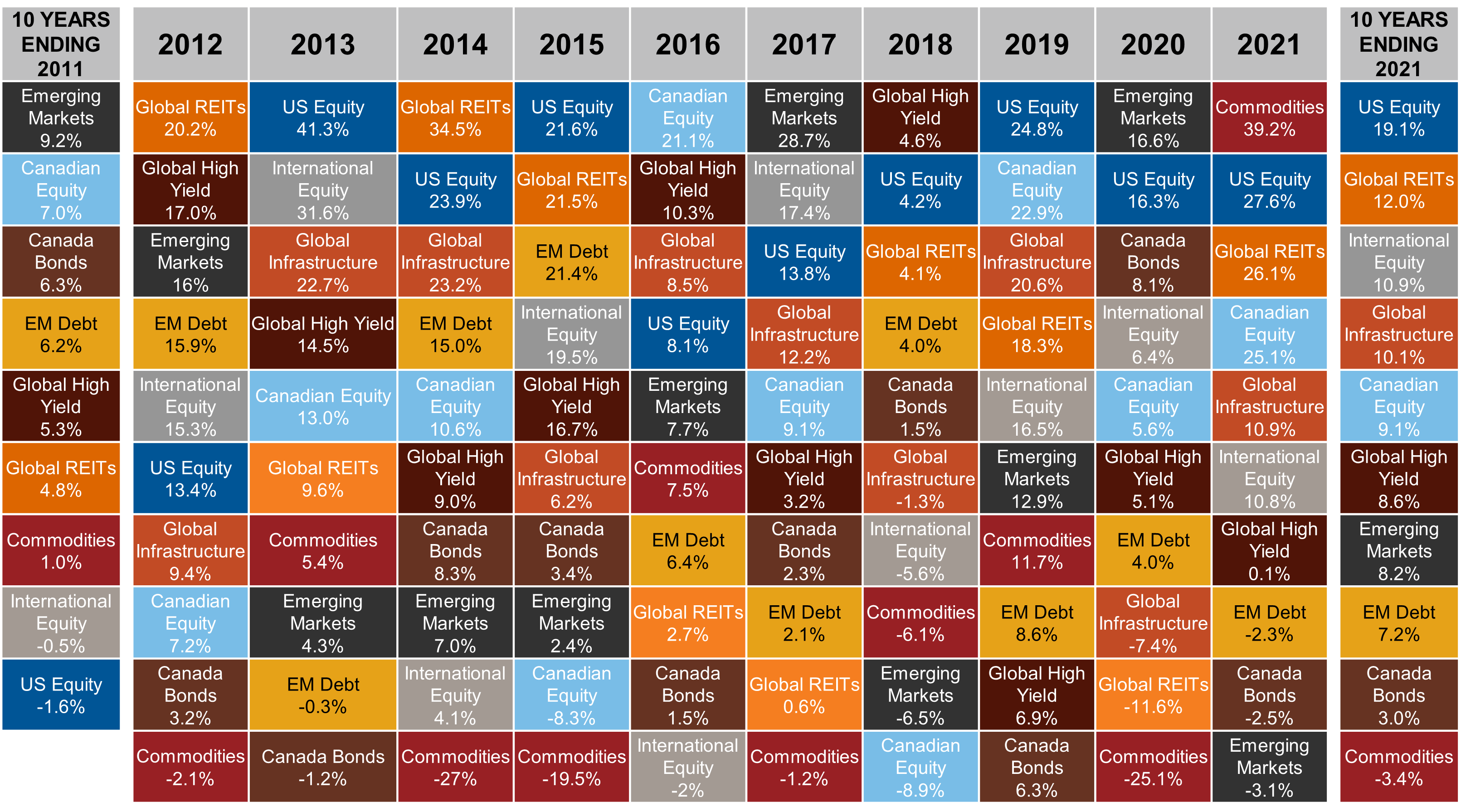Portfolio construction in the age of uncertainty
Diversifying an investment portfolio with different asset classes helps to smooth out the return of your investments over time and reduces the dependency on the performance of a single asset class. But what should you do when bonds and equities fall at the same time?
Never too much or too little
Success in investing over the long-term isn’t just about picking winners. The safest way to grow wealth over the long-term is to construct a portfolio that can navigate different market environments.
This means spreading investments over as wide a terrain as possible, minimizing the exposure should a stake in any single sector, company or fund take a tumble. Putting money in as many pots as possible can help to capture new opportunities when they arise, too.
There may be chances to make strong short-term returns in individual sectors or companies – the recent surge in oil prices is a good example. But making bets on which stocks will perform well is a difficult game with uneven results. Even if your hunch proves correct, it’s difficult to time any anticipated rise or plunge correctly.
By adopting a balanced diversified approach (which means avoiding concentration of your wealth in one single asset class), a portfolio stands a better chance of achieving smoother returns over time.
Fixed income comes under scrutiny
Government treasury bills and corporate bonds are usually referred to as fixed income assets because they pay investors a set return until the maturity date, then get reimbursed. In a rapid rising environment for equity markets, we expect fixed income to underperform against equities, but the risk attached to them is much lower. A smartly diversified portfolio should have both, to avoid the sharp variability of performance that equity markets generate.
The recent performance of fixed income markets has generated some questions around the ability of that asset class to offer relevant diversification at a time where equity markets were falling. The reality is that fixed income investments have faced a perfect storm of unique market circumstances since the beginning of the year. The post-pandemic surge in inflation has been aggravated by the war in Ukraine (causing commodity prices to skyrocket), and by further lockdowns in China (which have further disrupted global supply chains). To keep up with these rapidly changing market dynamics, central banks have been forced to end their ultra-loose monetary policies and have therefore been raising their benchmark rates. As a result, fixed income investments have fallen in value. At the same time, equity markets have been selling off due to the war in Ukraine and the risk of an economic slowdown following rapid changes in monetary policy in various regions. Against this backdrop of severe volatility, bonds and equities have sold off at the same time and therefore, bonds have failed to play their traditional role of safe haven.
Bonds still smooth out returns over time
When considering the value of a particular investment, it’s important to look at the bigger picture. Bonds didn’t offset falling equity values in the first quarter of 2022. But if we look at returns over a longer investment period, investors without any fixed income in their portfolio would have been worse off. The same was true during the depths of the COVID pandemic in early 2020, when having fixed income smoothed out returns at a time when the S&P/TSX Composite Index fell more than 37%.1
The chart below shows the performance of U.S. bonds versus U.S. stocks since 1976. Of all the negative quarters we’ve seen for U.S. stocks in that time, U.S. bonds have outperformed equities 47 out of 50 times. This is one of the strongest correlations between asset classes that there is.
Click image to enlarge
Source: Morningstar. Stocks: S&P 500 Index; Bonds: Bloomberg U.S. Aggregate Bond Index; Index returns represent past performance, are not a guarantee of future performance, and are not indicative of any specific investment. Indexes are unmanaged and cannot be invested in directly.The simultaneous sell-off of bonds and stocks earlier this year came at a time when monetary policy and markets had to suddenly adapt to higher interest rates, soaring inflation and slow growth. Over the longer-term however, the value of fixed income in controlling overall exposure is unambiguous.
Risk management in uncertain times
Investors today are facing an environment the world has not seen since the 1980s. That era was another time of high inflation and low growth. Many investors weren’t active then and some weren’t even born.
We believe risk tools are more important now than ever. It’s easy to say today that a portfolio should have more exposure to commodities, but that ignores the fact that commodities consistently performed poorly for the previous eight years. The top performing asset class has changed every year for the past decade.
Market leadership has changed over time
Click image to enlarge
Source: Morningstar Direct, Russell Investments. Annualized return in CAD. Canadian equity=S&P/TSX Composite Index, US Equity=S&P 500 Index, International Equity=MSCI EAFE Index, Emerging Markets=MSCI Emerging Markets Index, Canada Bonds=S&P Canada Aggregate Bond Index, EM Debt= JP Morgan Emerging Market Bond Index, Global High Yield=Bloomberg Global High Yield Index, Global Infrastructure=S&P Global Infrastructure Index, Global REITs=FTSE EPRA NAREIT Developed REITS Index, Commodities= S&P Goldman Sachs Commodities Index, Indexes are unmanaged and cannot be invested in directly. Past performance is not indicative of future results. Index performance does not include fees and expenses an investor would normally incur when investing in a mutual fund. Diversification and strategic asset allocation do not assure profit or protect against loss in declining markets.
Commodity prices have been affected by concerns about their volatility as well as a shift towards renewables. Meanwhile, low interest rates were not favorable to value stocks – such as banks – but fueled the rise of the tech companies helping to digitize our societies.
Winners rotate, so picking the right stock one year is no guarantee of success in the future. Investors in a single asset class can find themselves vulnerable when the winds change.
The bottom line
It’s important to have conviction and place bets when you believe that one asset class or manager will overperform, but balance is key. Success over the long-term means constructing a portfolio that is resilient and can perform well in multiple scenarios, not just one.
Putting all your eggs in one basket might work for a while. But if there is a market reversion – and there’s always one eventually – you may find yourself badly exposed without proper diversification. This strategic approach might mean that you’re never top of the pile in terms of returns over a short investment horizon, but it should also mean that you avoid the bottom of the pile as well. However, over the long term, being invested in a well-diversified portfolio may give you a better chance of reaching your desired investment outcome.
1Source: Refinitiv DataStream.

